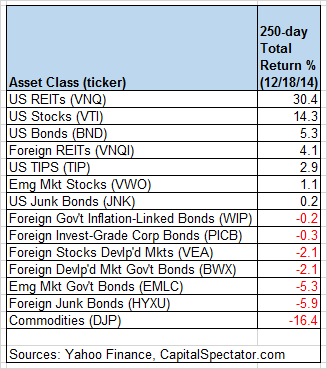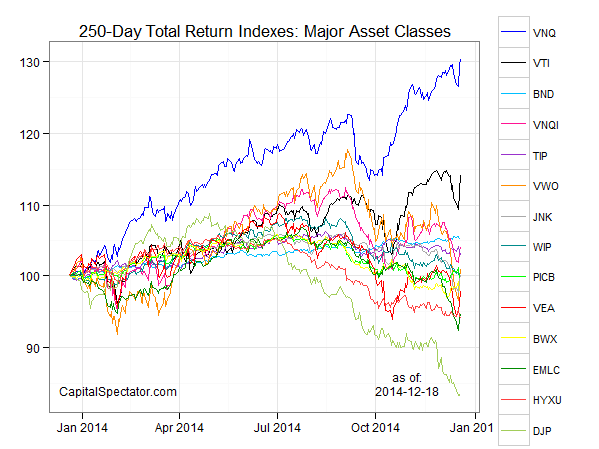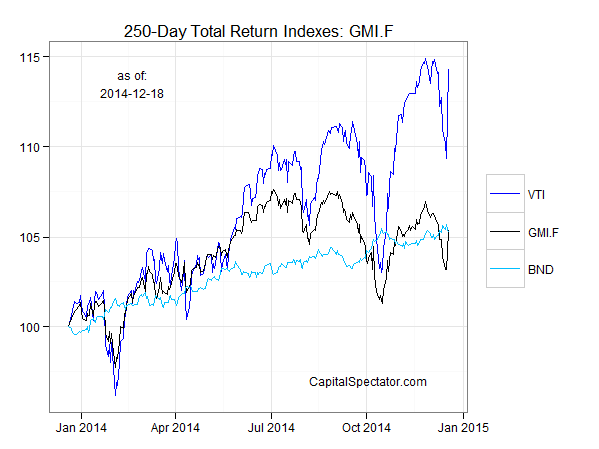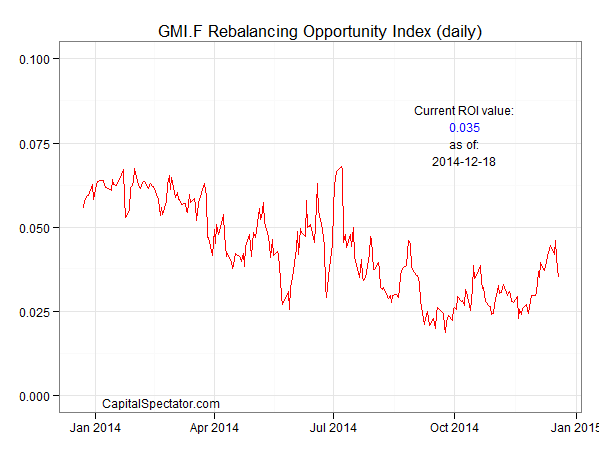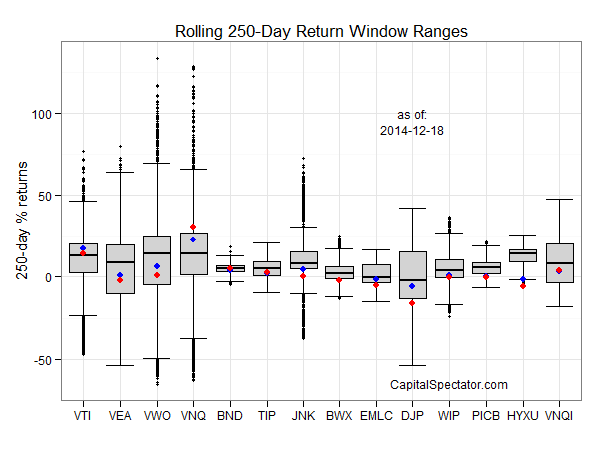It’s all about real estate investment trusts (REITs) these days when it comes to bullish performance among the major asset classes via our standard list of ETF proxies for the key slices of global markets. US REITs, to be precise, are enjoying a melt-up moment. But don’t confuse the stellar results with foreign REITs, which are posting only modest gains. US shares of securitized real estate, by contrast, have roared higher over the trailing one-year period (defined here as the past 250 trading days). Although prices have eased in recent days, Vanguard REIT (VNQ) is ahead by a hefty 30.4% through yesterday (Dec. 18). That’s twice the rise for the second-best performer, US equities, based on the Vanguard Total Stock Market (VTI).
US REITs are hot, but elsewhere there’s plenty of red ink weighing on the trailing one-year results in the waning days of 2014. Commodities, broadly defined, remain the point man for the losers. Selling raw materials has accelerated in recent weeks, leaving the iPath Bloomberg Commodity Index ETN (DJP) lower by 16.4% for the trailing 250-trading-day period at yesterday’s close.
Here’s a graphical recap of the relative performance histories for each of the major asset classes for the past 250 trading days via the ETF proxies. The chart below shows the performance records through Dec. 18, 2014, with all the ETFs rebased to a starting-value of 100:
Next, let’s review an ETF-based version of an unmanaged, market-value-weighted mix of all the major asset classes — the Global Market Index Fund, or GMI.F, which holds all the ETFs in the table above. Here’s how GMI.F stacks up for the past 250 trading days through Dec. 18, 2014. This investable strategy is up 5.4% over that span — well below the performance for US stocks (VTI) but only fractionally better than the trailing return for a broad measure of US bonds (BND).
Comparing the median dispersion for 250-day returns for the major asset classes via ETFs suggests that the general rebalancing opportunity has improved a bit for GMI.F vs. recent history. But this slight rise is a rebound from a period of unusually low median values. As a result, analyzing the components of GMI.F with a rolling median absolute deviation via one-year returns for the ETFs — the GMI.F Rebalancing Opportunity Index, as it’s labeled on these pages — suggests that there’s limited potential for adding value by reweighting this portfolio in comparison with recent history. Keep in mind that the opportunity for productive rebalancing will vary depending on the choice of holdings and historical time window. In addition, don’t overlook the possibility that any given pair of ETFs may present a substantially greater or lesser degree of rebalancing opportunity vs. analyzing GMI.F’s components collectively, which is the methodology that’s reflected in the chart below. Also, the chart below focuses on looking backward — if you’re confident in your forecast for risk and return, the ex ante view of rebalancing opportunity may paint a distinctly different outlook vs. an ex post analysis.
Finally, let’s compare the rolling one-year returns for the ETFs in GMI.F via boxplots for a revealing comparison of price momentum. The gray boxes in the chart below reflect the middle range of historical 250-day returns for each ETF—i.e., the 25th to 75th return percentiles. The red dots show the current return (as of Dec. 18) vs. the 250-day return from 30 trading days earlier (blue dots, which may be hiding behind the red dots in some cases). The conspicuous outliers at the moment: US REITs (VNQ) on the upside with commodities (DJP) at the bleeding edge of the downside.
The ETF Asset Class Performance Review, which offers a deeper look
at an ETF-based view of asset classes. For more information and a
recent sample, see CapitalSpectator.com/premium.
